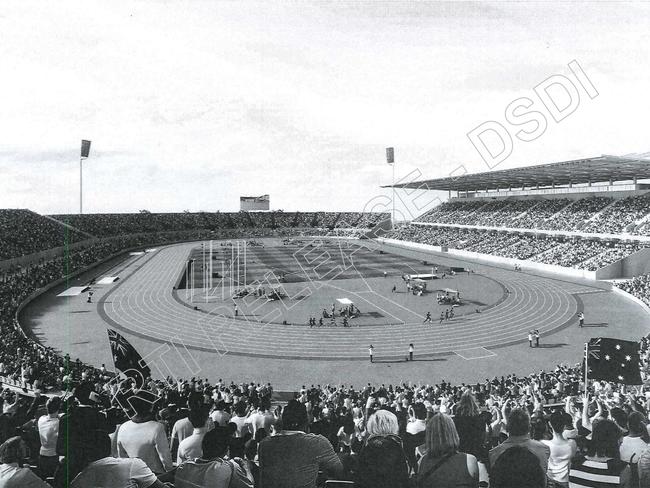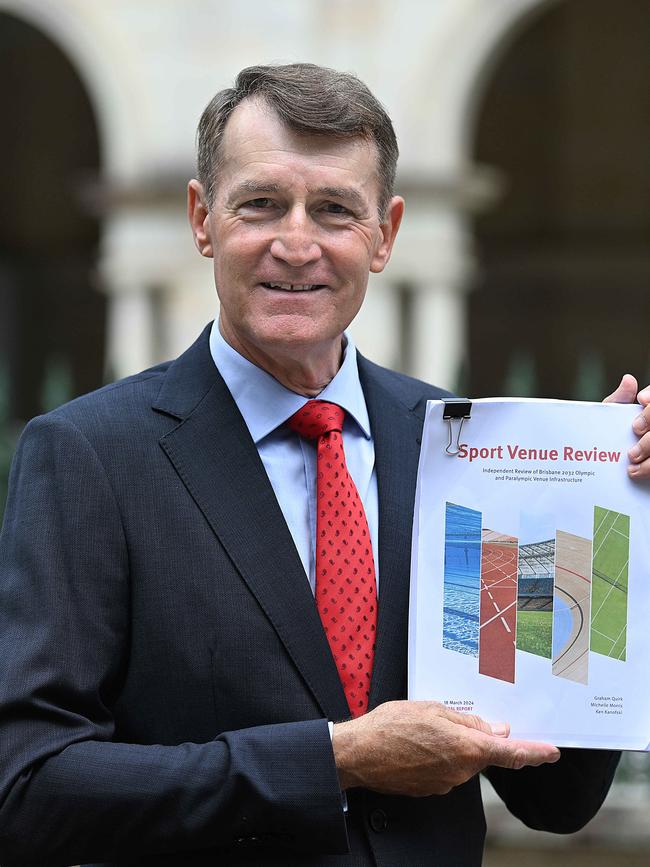Cases for and against Brisbane stadium plans for 2032 Olympic Games
It’s been labelled an Olympic bungle of gold medal proportions – but what are the cases for and against each stadium proposal? HOW YOU VOTED
QLD News
Don't miss out on the headlines from QLD News. Followed categories will be added to My News.
It’s been labelled an Olympic bungle of gold medal proportions.
Brisbane’s Games stadium saga has drawn the ire of officials, readers and Olympians as debate continues over what the 2032 showpiece should look like.
Swimmer Cate Campbell in March 2024 weighed in over the toing and froing regarding the best location for the Olympic stadium.
By July the conversation had moved on to the size.

Rebuilding the Gabba was an early suggestion, one that had since had several reincarnations.
Plans revealed in December 2024 to construct a new 60,000-seater stadium at Victoria Park also won some fans, while the potential to redevelop QSAC was been met with both positive and negative reviews.
In August there was a $6bn proposal at Northshore put forward to solve the 2032 Games planning debacle – and it wouldn’t cost taxpayers an extra cent.
By January 2025 it was claimed Brisbane’s Olympics could save $5bn and use the extra cash to fund a new main stadium at Doomben Racecourse, according to a proposal presented to the 2032 review.
The Albion Park proposal had grown legs by February 2025.
So what is the best bet? Or should, as some have suggested, the Games just be cancelled completely?
Readers have repeatedly voted overwhelmingly for Victoria Park to get the nod, with a majority selecting that as the preferred option.
See the case for and against each stadium below and join the conversation >>>
Best site for main Olympics stadium?
Rebuilt Gabba
The case for
There is existing infrastructure which would not require a new stadium, plus it is already world-renowned and has suitable public transport.
Upgrading the Gabba would also be ideal to host more cricket and AFL at the venue before being used for the 2032 Olympic Games.
State Development Director-General Mike Kaiser in August 2023 acknowledged the $2.7bn Gabba redevelopment had divided the community but stressed “the value for money outcome is a tear down and rebuild.”
Graham Quirk’s 60-day Olympic Games’ venue review found the venue is a good viewing experience.
The case against
The cost of $2.7bn – and whether it could end up even higher – remains a sticking point, with Olympic powerbroker John Coates previously declaring the project is damaging the Games brand and “just doesn’t stack up”.
Mr Coates called for the rebuild to be axed in favour of an opening and closing ceremony at Suncorp Stadium and the athletics at the Queensland Sport and Athletics Centre (formerly QEII Stadium) on the city’s southside.
Mr Coates said he held concerns about using the Gabba for athletics due to the requirement for a warm-up track nearby. The location also means it there are expansion limitations.
The proposal to use Raymond Park also drew strong community opposition which, combined with the plan to demolish East Brisbane State School for the Gabba rebuild, diminished support.
Graham Quirk’s review also found it had access issues, while major sports would be displaced during its rebuild.
Victoria Park
The case for
There is the view that Victoria Park could be transformed into a world-class sporting, events and knowledge precinct for a similar price as the current plan to demolish and rebuild the Gabba and build Brisbane Arena over the Roma Street railway.
Under plans it would be connected above the Inner City Bypass to create a massive 90ha sporting and events venue precinct with a 70,000-seat stadium and Brisbane indoor arena.
In March 2024 Peter Edwards, the founder of architect firm Archipelago, said the $500m per year expenditure on the Olympic infrastructure was “not that much” compared to the state’s $87bn annual budget – including $15bn in coal royalties alone.
Brisbane Lord Mayor Adrian Schrinner has also said he would back building a brand-new stadium at the council-owned Victoria Park – as long as the stadium footprint was kept to a minimum, there was no net loss of parkland, and the stadium delivered a cheaper option than knocking down and rebuilding the Gabba.
Mr Edwards noted the Victoria Park site was within a 20-minute walk of three railway stations – including Exhibition on the $6.3bn Cross River Rail.
In December a new report found a 60,000-seat stadium could be built at Victoria Park for $2.6bn as part of a major Olympic sporting precinct that would rival Melbourne and London to deliver a lasting legacy.
In March 2025 it was revealed a state-of-the-art swimming arena to be built across the road from a new Victoria Park stadium was firming as a surprise Brisbane 2032 Olympic option.
The case against
Many have expressed their concern over the use as public parklands, plus the exact costs have been tipped to grow from the proposed $3.4bn.
Then Deputy Premier Cameron Dick had slammed Victoria Park as a “vanity project”.
While Federal LNP MP for Fairfax Ted O’Brien – a former member of the 2032 Organising Committee for the Olympic Games – said the state government’s decision to “entirely own” infrastructure delivery at the expense of an independent authority “has proven to be a disaster”.
Graham Quirk’s review found the build may also have ripple cost impacts on the rail network and public transport.
There are also concerns about build time, “leaving little room for unanticipated delays”.
Northshore
The case for
The bold plans for a mega precinct with a stunning 60,000-seat waterfront stadium wouldn’t cost taxpayers an extra cent.
A group of globally renowned architects – including the firm behind some of the best stadiums in the world such as Los Angeles’ SoFi Stadium and the Dallas Cowboys Stadium – put forward the plan to transform Brisbane’s Northshore into a one-stop Olympic precinct.
The proposed Northshore stadium would be the centrepiece of the precinct, which would include a hotel overlooking the venue, a 2500-apartment athletes’ village, pedestrian walkways along the river, an aquatic and wavepool centre as well as a retail and restaurant hub.
Dubbed the Brisbane Design Alliance, the team of world-class architecture, engineering and planning experts from Buchan, HKS, NRA Collaborative, Aurecon and Nikken Sekkei believes the project could be funded privately – similar to Perth’s Optus Stadium, which HKS designed.
The case against
Minister Di Farmer quickly shot down the concept, saying the government wanted to own its Olympic stadium and had already issued tenders for QSAC upgrades and the Hamilton athletes village.
“We are already investing heavily in the Northshore area, we’ve already got dwellings there, we have already put out a proposal and tender for the athletes village,” she said.
“The government is always interested in private investment … but I think that the die has been set.
“We want to move forward.”
Ms Farmer said the government had already steered toward its own investment in Northshore after promising to build 3000 social and affordable homes.
QSAC
The case for
It was revealed then Premier Steven Miles decided to ignore an independent Olympics review and push ahead with spending $1.6bn to upgrade the Queensland Sport and Athletic Centre because Games powerbroker John Coates suggested it.
Mr Coates argued the upgrade to Nathan’s QSAC for Olympic track and field events could be completed for as little as $500m to $600m – with IOC experts made available to travel to Australia to assess required work.
Instead, he put forward a proposal use Nathan’s QSAC for athletics, with the grandstands demolished and a permanent replacement built on the western side.

The case against
The Olympic athletics stadium would be the smallest since the Amsterdam Games held 104 years earlier and give residents “little opportunity” to see finals events in 2032.
QSAC pales in comparison to the most recent venue – Tokyo’s 68,000-seat Japan National Stadium – which was rebuilt for the 2021 Games’ ceremonies and athletics but sat largely empty due to the Covid pandemic.
An independent 60-day infrastructure review also warned against spending $1.6bn to upgrade QSAC due to “limited legacy opportunities” it would provide for the city – and found it would not offer value to taxpayers.
“At $1.6 billion to upgrade the old stands, plus the other $1 billion needed to keep the Gabba going beyond 2032, the QSAC option isn’t exactly cheap,” Brisbane Lord Mayor Adrian Schrinner said.
He also noted issues with getting people to and from QSAC, saying mass transport to the stadium was “notoriously bad”.
In March State Development Minister Grace Grace admitted the government had not yet factored in the cost of mass public transport upgrades in its budget.
By July there were fresh fears for the plan and whether it would leave a hole in the $1.29bn ticket revenue target.
Doomben Racecourse
The case for
In January 2025 it was claimed Brisbane’s Olympics could save $5bn and use the extra cash to fund a new main stadium at Doomben Racecourse.
Gold Coast Mayor Tom Tate delivered the city’s formal submission to the 2032 Olympics and Paralympics Review, with the 32-page document outlining how the blockbuster event could save billions of dollars by using or enhancing existing venues, such as the Gold Coast Aquatic Centre, creating additional budget to solve Brisbane’s stadium dilemma once and for all.
Cr Tate said installing a roof and a 10,000-seat stadium at the Gold Coast Aquatic Centre could be done substantially cheaper than the planned temporary pool at a new Brisbane arena.
However he said the potential savings to be gleaned from his city’s submission could create scope for Brisbane to build a world-class Olympic stadium – at Doomben Racecourse.
The case against
The proposal was news to Brisbane Racing Club with CEO Karl deKroo, who said he was surprised by Cr Tate’s decision to include Doomben in his proposal without prior consultation with the BRC.
“Our position has always been to recognise the significance of the 2032 Olympics and the opportunity the Games present for Brisbane and Queensland,” he said.
“We remain open to engaging with the government on the role our club can play in the broader infrastructure plan.
“However, any proposal that would lead to the cessation of racing at Doomben demonstrates a clear lack of understanding of its critical role in sustaining the thoroughbred racing industry in Queensland.”
Albion Park
Case for
A simple stadium erected on top of the old Albion Raceway track is a cheaper and quicker solution to the state government’s Olympic Games woes, a new development group declared in February 2025.
The Albion Olympic Park team put forward a simple stadium design for consideration as Brisbane’s main stage for 2032, with hopes the government will be swayed by the no-frills proposal that promises a smaller price tag.
A basic architectural design, the 45,000 to 55,000 seat stadium would feature curtain walling and a bare outer perimeter of the stadium, with a sizeable viewing screen on it’s exterior to allow for an additional 10,000 attendees to view the Games from the surrounding parklands.
The case against
The proposal did hit the mark with many readers, who suggested it was another proposal that would leave Brisbane as a laughing stock.
Some insisted it was too small; others said it was half-baked.
Originally published as Cases for and against Brisbane stadium plans for 2032 Olympic Games


